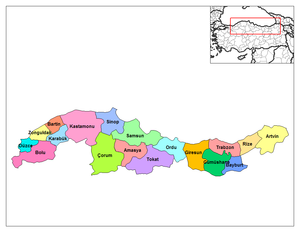

Black Sea Turkey (Turkish: Karadeniz Bölgesi) in northern Turkey, is a humid and verdant region renowned for its natural beauty thanks to the high precipitation levels distributed evenly throughout the year. The region is very mountainous and is heavily forested, while the highest parts of the mountains are covered with alpine meadows, glacier lakes, and glaciers.
The region covers much of the country's northern coast, but the western stretch of the Black Sea coast is a part of the Marmara Region.
Regions
[edit]| Eastern Karadeniz This region boasts astounding natural beauty, colorfully dressed Hemşin women, many Georgian ruins hidden in the mountains, and perhaps the world's most spectacularly situated monastery. |
| Central Karadeniz Central Karadeniz is home to the Turkish Black Sea coast's largest city, Samsun, beautiful riverside Ottoman architecture in Amasya, and Hittite ruins galore. |
| Western Karadeniz The western third of Turkey's Black Sea coast is its most remote and beautiful (having been spared the indignities of the coastal highway), home to the ancient fortified port city of Sinop, and the beautiful resort town of Amasra. |
Cities
[edit]- 1 Amasya — a historic city with riverside Ottoman mansions and ancient rock-cut tombs watching them from above
- 2 Amasra — a beautiful seaside resort town with a nice beach, pleasant vistas, and great fish restaurants
- 3 Giresun — a city standing out with its relatively lively nightlife; trips to a nearby island can be arranged from here
- 4 Rize — the heart of Turkey's tea growing region; not a real tourist attraction, but a good base for exploring the northeast
- 5 Safranbolu — a
 UNESCO World Heritage Site, this is a very well preserved Ottoman old town with a traditional streetscape and whitewashed houses
UNESCO World Heritage Site, this is a very well preserved Ottoman old town with a traditional streetscape and whitewashed houses - 6 Samsun — the largest city on the Turkish Black Sea coast with big city attractions: such as opera and museums. Also many sports, including wakeboarding in summer.
- 7 Sinop — an ancient fortified port city jutting out on a peninsula that is Turkey's northernmost tip
- 8 Trabzon — the main city of the northeast has a lot to offer a visitor, and is the place to stay when traveling to the stunning Sümela Monastery
- 9 Zonguldak — a bleak industrial city with coal mining heritage
Other destinations
[edit]
- 1 Abant — a resort around a mountain lake of the same name; fairly popular among the locals due to its easily accessible location near the Istanbul–Ankara motorway
- 2 Ayder — a village up in the lush Kaçkar Mountains/Pontic Alps
- 3 Hattusa — the ruins of the Hittite capital
- 4 Ilgaz National Park — a ski resort amidst beautiful fir forests
- 5 Sümela — a stunning monastery hanging on a cliff in the lush Altındere Valley
Understand
[edit]Climate
[edit]The climate is oceanic on the coasts; warm, showery summers (averaging around 25-27°C during the day, 10-15 days of rain a month), mild transitional seasons, and cool, wet winters (averaging around 6-10°C during the day, 15-20 days of precipitation a month). Snow is occasional in winter, and melts quickly. One important rule of thumb is that east-facing cities, such as Samsun and Sinop, are often better protected from storms than their west-facing counterparts, such as Zonguldak or Rize.
Mountainous regions have a colder and much snowier variant of the coastal climate; while lowlands far from the coasts are continental, with very warm, somewhat dry summers, and cold, snowy winters.
Get in
[edit]Get around
[edit]
The 350 km road from Amasra to Sinop is beautiful and breathtaking as it winds its way along the rugged coast. If you are depending on public transport, however, it is likely to take two days. Expect to spend a night in one of the small towns along the coast, such as Inebolu, as bus service is town-to-town, and you are likely to arrive at some town after the last dolmus has left. While the towns along the way are unspoilt and unpretentious, they are a bit run down. If you have your own car or motorcycle, you can do the journey in one day (start early).
See
[edit]Do
[edit]Eat
[edit]Drink
[edit]Stay safe
[edit]Go next
[edit]As the Black Sea Region spreads over most of northern Turkey elongatedly, getting out of the region involves heading for destinations hugely different in character:
- To the west, the Marmara Region has some of the country's greatest cities, packed full of historical sights.
- To the south, you have two inland options depending on where you pass through the coastal mountain range: the wide open steppes of Central Anatolia or the mountainous territory of Eastern Anatolia.
- To the east, Georgia is as lush as Black Sea Turkey, and has a great culinary tradition.

